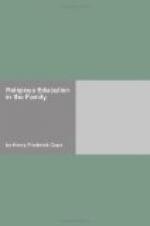CHAPTER PAGE I. An Interpretation of the Family 1
II. The Present Status of Family Life 10
III. The Permanent Elements in Family Life 27
IV. The Religious Place of the Family 37
V. The Meaning Of Religious Education in the Family 46
VI. The Child’s Religious Ideas 60
VII. Directed Activity 75
VIII. The Home as a School 87
IX. The Child’s Ideal Life 101
X. Stories and Reading 110
XI. The Use of the Bible in the Home 119
XII. Family Worship 126
XIII. Sunday in the Home 145
XIV. The Ministry of the Table 164
XV. The Boy and Girl in the Family 173
XVI. The Needs of Youth 183
XVII. The Family and the Church 198
XVIII. Children and the School 212
XIX. Dealing with Moral Crises 218
XX. Dealing with Moral Crises (Continued) 231
XXI. Dealing with Moral Crises (Continued) 240
XXII. Dealing with Moral Crises (Concluded) 249
XXIII. The Personal Factors in Religious Education 259
XXIV. Looking to the Future 268
Suggestions for Class Work 281
A Book List 290
Index 297
CHAPTER I
AN INTERPRETATION OF THE FAMILY
Sec. 1. TAKING THE HOME IN RELIGIOUS TERMS
The ills of the modern home are symptomatic. Divorce, childless families, irreverent children, and the decadence of the old type of separate home life are signs of forgotten ideals, lost motives, and insufficient purposes. Where the home is only an opportunity for self-indulgence, it easily becomes a cheap boarding-house, a sleeping-shelf, an implement for social advantage. While it is true that general economic developments have effected marked changes in domestic economy, the happiness and efficiency of the family do not depend wholly on the parlor, the kitchen, or the clothes closet. Rather, everything depends on whether the home and family are considered in worthy and adequate terms.




